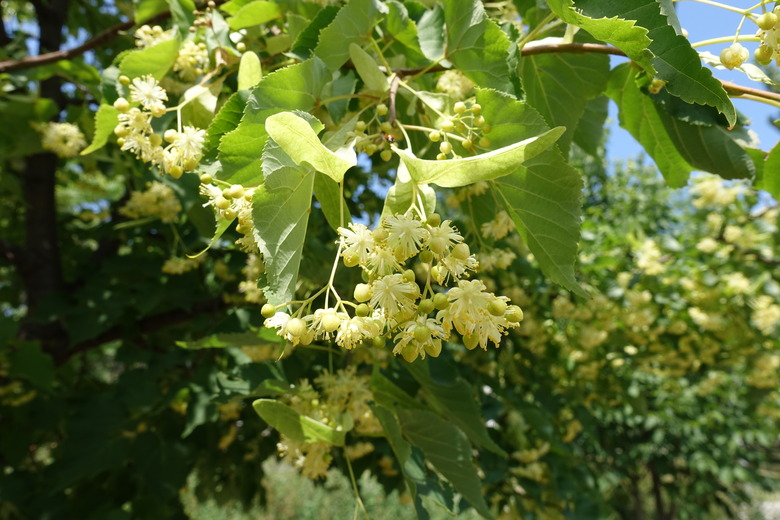What Does A Basswood Tree Look Like?
"Basswood" is the North American name for native trees of the genus Tilia, which includes roughly 30 species worldwide. In Europe and Asia, members of this genus are generally called lindens or limes.
Linden tree wood, including that of basswoods, is prized among cabinetmakers and instrument builders, while the broad leaves and fragrant flowers make these hardwoods popular street and shade trees.
In North America, basswoods are important and widespread members of central and eastern deciduous forests, and – outside of their winter barrenness, anyway – are quite easy to tell apart from the maples, beeches, ashes and other trees they commonly mingle with.
American Linden Tree: The Basswoods
American
Linden Tree: The Basswoods
The Tilia family tree in general is not completely agreed upon, and that includes just how many species North America hosts. Some scientists contend there's just one kind, the American basswood (Tilia americana), while others recognize anywhere from one to three other species.
Those other basswood types sometimes considered distinct species – or simply geographic varieties of the American basswood – include the white basswood (T. heterophylla) of the Appalachians primarily and the Carolina basswood (T. caroliniana) of the Southeast. The so-called Florida basswood is sometimes considered synonymous with the Carolina basswood, a subspecies of it or its very own species (T. floridana).
If the American basswood is defined separately from those forms, its range mainly includes the Midwestern and Northeastern United States and small portions of adjacent Canada. Taken together, the basswood tree varieties occupy most of the central and eastern U.S.
Basswood Shape, Size & Growth Form
Basswood
Shape, Size & Growth Form
The American and white basswood tree typically boasts straight trunks clear of lower branches that rise to fairly compact, spreading and broadly rounded canopies. Both types are good-sized trees: They often grow to 60 or 80 feet in height, with exceptional specimens of American basswood soaring to 130 feet or more tall and with trunks five or more feet across.
Carolina basswoods are smaller trees, normally growing 20 to 40 feet tall with a trunk less than two feet in diameter. Their crowns tend to be more irregular-looking, and the trees often exhibit leaning or multiple trunks.
Basswoods readily sprout from stumps, the suckers able to grow into mature trees when the original dies from old age, fire or other causes and given a leg up on seed-sprouted basswoods because of the existing root system. This often results in clustered rings of basswoods, a common sight in central and eastern forests.
Trunk Color and Texture
Trunk
Color and Texture
As in many broadleaf trees, the trunks of young basswoods wear smooth bark, but this roughens with age. The bark of older basswoods is thin and textured with ridges and furrows. The color ranges between dull gray and gray-brown to almost black.
The Big, Broad Leaves of Basswoods
The Big, Broad Leaves of Basswoods
Basswood leaves, which are deciduous, are highly distinctive. They're roughly heart-shaped and typically asymmetrical, with serrated edges and a pointed tip. They're also big, often 7 or more inches long and 4 inches wide, substantially bigger than most of the Eurasian lindens, such as the littleleaf and silver lindens, commonly planted as street trees in the U.S.
In the growing season, basswood leaves tend to be a deep green with a paler underside. In fall, the leaves brighten to a yellowish-green chartreuse or golden yellow, sometimes intermixed with pale green foliage.
The leaves of the American basswood are initially hairy but become smooth when full-grown. The undersides of Carolina and white basswood leaves, meanwhile, often remain hairy into maturity.
Flowers & Fruits
Flowers
& Fruits
Even more instantly recognizable than basswood leaves are the trees' reproductive structures. The small clustered flowers, which range in color from creamy to yellowish or greenish, hang by a long stalk from a modified leaf called a bract that's 4 to 5 inches in length and tongue-shaped.
Those basswood flowers, which tend to appear from late spring to early summer and are prized both for their perfume and their honey, turn into round, quarter-inch nuts in fall, hanging from the dried and browned bract.
References
- Chippewa National Forest: Autumn Tree Identification
- U.S. Department of Agriculture: Plant Guide – Carolina Basswood
- The Sibley Guide to Trees, David Allen Sibley
- The Complete Trees of North America: Field Guide and Natural History; Thomas S. Elias
- USDA Forest Service: Silvics of North America – American Basswood
- USDA Forest Service: Silvics of North America – White Basswood
Cite This Article
MLA
Shaw, Ethan. "What Does A Basswood Tree Look Like?" sciencing.com, https://www.sciencing.com/basswood-tree-look-like-5728991/. 22 November 2019.
APA
Shaw, Ethan. (2019, November 22). What Does A Basswood Tree Look Like?. sciencing.com. Retrieved from https://www.sciencing.com/basswood-tree-look-like-5728991/
Chicago
Shaw, Ethan. What Does A Basswood Tree Look Like? last modified March 24, 2022. https://www.sciencing.com/basswood-tree-look-like-5728991/
